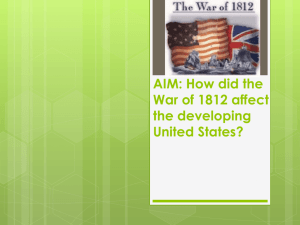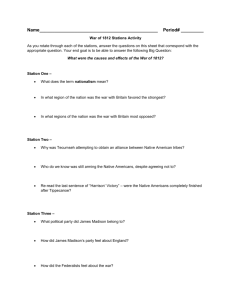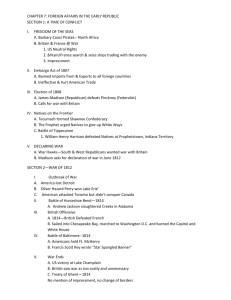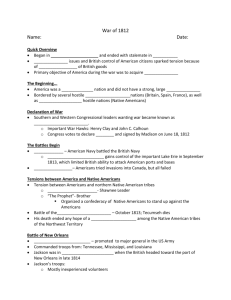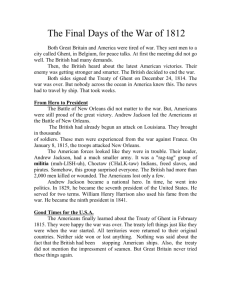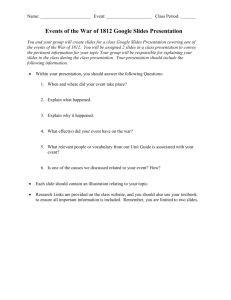The War of 1812
advertisement
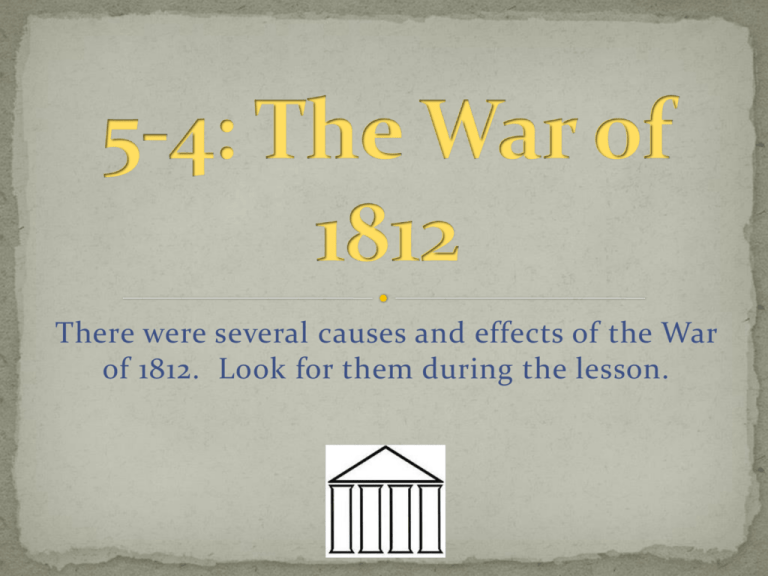
There were several causes and effects of the War of 1812. Look for them during the lesson. The first three U.S. Presidents worked hard to avoid war with Britain and France. Despite these efforts, the U.S. finally went to war. Social Studies Standard 8.5.1: Understand the political and economic causes and consequences of the War of 1812 and know the major battles, leaders, and events that led to the final peace. Social Studies Standard 8.5.3: Outline the major treaties with American Indian nations during the administrations of the first four presidents and the varying outcomes of those treaties. nationalism: pride in one’s country. war hawks: those who were eager for war with Britain. blockade: the action of shutting a port or road to prevent people or supplies from coming into an area or leaving it. secede: withdraw The Move Toward War Led by the war hawks, Congress declared war on Britain in June 1812. Americans were angry with Britain over two main issues when James Madison took office in 1809: The arming of Native Americans in the Northwest The continued impressment of American sailors In 1810, Henry Clay of Kentucky and John C. Calhoun of South Carolina became leaders in the House of Henry Clay Representatives. The Move Toward War Led by the war hawks, Congress declared war on Britain in June 1812. Clay and Calhoun led a group of war hawks who were eager for war with Britain. Merchants in New England were against the war because they relied on trade with Britain and other European countries. Strong nationalism, pride in one’s country, led to a declaration of war in June, 1812. John C. Calhoun Early Days of the War During the first year of war, the U.S. struggled to rebuild American military strength weakened by Jefferson’s spending cuts. The navy had only 16 warships. The army had fewer than 7,000 soldiers. Many officers were poorly trained or too old for combat. The British set up a blockade of the American coast. The War in the West & South Native Americans suffered severe setbacks during fighting in the West and the South during 1814. The Americans failed in an attempt to invade Canada in July, 1812. The British captured more than 2,000 American soldiers. In 1813, American forces led by Oliver Hazard Perry defeated the British at Detroit, forcing them back into Canada. The Americans under General William Henry Harrison defeated the British at William Henry Harrison the Battle of the Thames in Canada. The War in the West & South Native Americans suffered severe setbacks during fighting in the West and the South during 1814. Tecumseh was killed in the battle. In the South, Andrew Jackson defeated the Creeks at the Battle of Horseshoe Bend in March, 1814. The treaty forced the Creeks to give up millions of acres of land. Andrew Jackson Final Battles Although the War of 1812 had no clear victor, Americans gained new confidence after its end. The British attacked Washington, D.C. in August, 1814 and set fire to several government buildings, including the White House. The British attacked Fort McHenry, which defended the harbor at Baltimore. Francis Scott Key wrote a poem, after he watched the attack, that he called “The Star-Spangled Banner.” Francis Scott Key In 1931, Congress made it our national anthem. Final Battles Although the War of 1812 had no clear victor, Americans gained new confidence after its end. By 1814, Britain had tired of the war. On December 24, 1814, Britain and the U.S. signed the Treaty of Ghent, which ended the war. In January 1815, American forces under General Andrew Jackson won a stunning victory over the British at the Battle of New Orleans. The War of 1812 was the “Second War Andrew Jackson of Independence” to many Americans. HOMEWORK EXTENSION Complete the Section Quiz for 5-4 Write a detailed SUMMARY of the section and complete the UNANSWERED QUESTIONS section of your notes. Choose two of the remaining Depth & Complexity ICONS in your notes and explain how they relate to this section.

